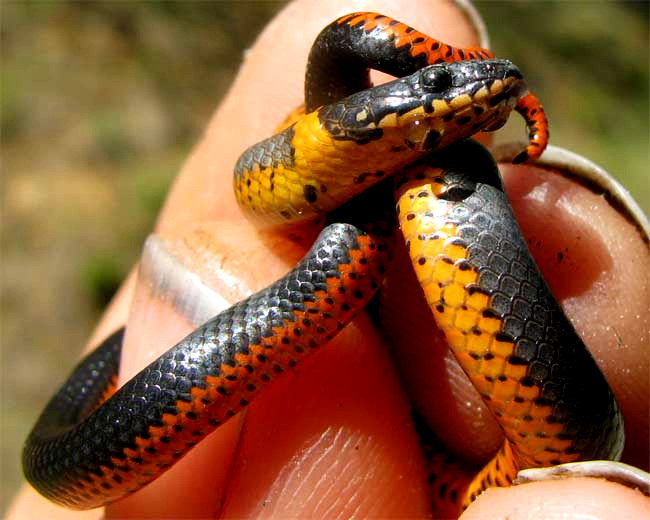Excerpts from Jim Conrad's
Naturalist Newsletter

from the May 24, 2009 Newsletter, issued from the Siskiyou Mountains west of Grants Pass, Oregon:
OREGON'S VERSION OF THE RINGNECK SNAKE
Bob and my friends drove me up to Onion Mountain 17 miles away, we had a picnic with a great view, and they left me there, to camp overnight and walk back the next day. During my descent, on the narrow gravel road just as it was warming up, I encountered the first snake I've seen since being here, which you can see above.
That's a Ringneck Snake, DIADOPHIS PUNCTATUS, and if you don't live around here and have Ringnecks in your area you may see certain ways this Ringneck differs from yours. Ringneck Snakes occur from southeastern Canada through most of the US into Mexico, fracturing along the way into about fourteen different-looking subspecies. Our subspecies is Diadophis punctatus ssp. occidentalis, the "Northwestern Ringneck," distributed mostly from southwestern Washington through extreme western Oregon, to Sonoma County, California. Our subspecies differs from others by having an especially wide neck ring and an orange belly that is lightly spotted. The bellies of other subspecies range from yellow to cream to red, and are unspotted or heavily spotted.
Ringneck Snakes only reach about 14 inches long. Their mouths are so small they couldn't bite a finger if they tried. They live under rotting logs, wood, and rocks and often are seen on roads and paths. They eat insects, frogs and salamanders, other small snakes, lizards, and newborn rodents.